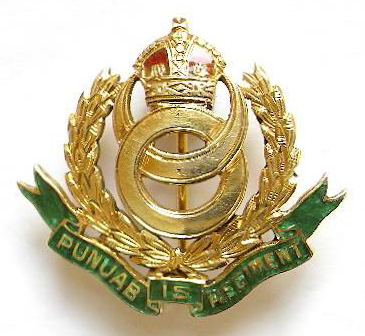Active 1922 - 1956 Uniform Scarlet; faced buff | Branch Army | |
 | ||
Country British India 1922 - 47 Pakistan 1947 - 56 | ||
The 15th Punjab Regiment was a regiment of the British Indian Army from 1922 to 1947. It was transferred to Pakistan Army on independence in 1947, and amalgamated with the 1st, 14th and 16th Punjab Regiments in 1956 to form the Punjab Regiment.
Contents
Early History
The 15th Punjab Regiment was formed in 1922 by the amalgamation of the 25th, 26th, 27th, 28th and 29th Punjabis. All five battalions were raised during the upheaval of the Indian Mutiny in 1857 by John Lawrence in the Punjab. The 27th Punjabis served in China during the Second Opium War in 1860-62, while the 26th and 29th Punjabis participated in the Bhutan War of 1864-66. All battalions saw service on the North West Frontier of India and took part in the Second Afghan War of 1878-80, while the 26th and 27th Punjabis also served in the Third Anglo-Burmese War of 1885-87. In 1901, the 27th Punjabis were dispatched to British Somaliland to suppress the resistance movement led by the Somali religious leader Abdullah Hassan of the Dervish State.
First World War
During the First World War, the five battalions of 15th Punjab Regiment served with distinction in all the major theatres of war.
All war-raised battalions were disbanded after the war. In 1921-22, a major reorganization was undertaken in the British Indian Army leading to the formation of large infantry groups of four to six battalions. Among these was the 15th Punjab Regiment. The line-up of battalions for the 15th Punjabis was:
The class composition of the new regiment was Punjabi Muslims, Sikhs and Jats. The new regimental badge was a Muslim crescent entwined with a Sikh quoit, surrounded by a wreath and surmounted by a Tudor crown with a scroll below, which read "15th Punjab Regiment". The uniform was scarlet with buff facings. Sialkot in the Punjab was chosen as the permanent station for the Training Battalion. In 1921, Sepoy Ishar Singh of the 28th Punjabis was awarded the Victoria Cross during an action in Waziristan on the North West Frontier.
Second World War
During the Second World War, the 15th Punjab Regiment raised ten new battalions. Most of the active battalions were engaged in fighting the Japanese in the Far East except the 3rd Battalion, which fought in Somaliland and Italy. Performance of the 4th Battalion in Burma in particular was outstanding. The battalion suffered 921 casualties and was awarded numerous gallantry awards including two Victoria Crosses to Lieutenant Karamjeet Singh Judge and Naik Gian Singh.
Post Independence History
On the independence of Pakistan in 1947, the 15th Punjab Regiment was allotted to Pakistan Army. At the time, the active battalions were 1st, 2nd, 3rd and 4th. Sikhs and Jats were transferred to the Indian Army and the regiment's new class composition was fixed as Punjabis and Pathans. The regiment's badge was also modified and the Sikh quoit was replaced by an Islamic star. In 1948, the 2nd and 3rd Battalions fought in the war with India in Kashmir. In 1956, a major reorganization was undertaken in the Pakistan Army and larger infantry groups were created by amalgamating the existing infantry regiments. As a result, the 15th Punjab Regiment was amalgamated with the 1st, 14th and 16th Punjab Regiments to form one large Punjab Regiment. The four regimental centres were also merged and the combined centre moved to Mardan. The line up of the new regiment was:
Battle Honours
China 1860-62, Ali Masjid, Peiwar Kotal, Charasiah, Kabul 1879, Ahmad Khel, Kandahar 1880, Afghanistan 1878-80, Burma 1885-87, Chitral, Somaliland 1901-04, Loos, France and Flanders 1915, Suez Canal, Egypt 1915, Megiddo, Sharon, Palestine 1918, Tigris 1916, Kut al Amara 1917, Baghdad, Mesopotamia 1915-18, Persia 1918, NW Frontier, India 1917, Kilimanjaro, East Africa 1914-17, Berbera, Assab, Abyssinia 1940-41, Tug Argan, British Somaliland 1940, The Sangro, The Moro, Cassino II, Gothic Line, The Senio, Italy 1943-45, West Borneo 1941-42, South East Asia 1941-42, Rathedaung, Donbaik, Jail Hill, Naga Village, Kyaukmyaung Bridgehead, Mandalay, Fort Dufferin, Meiktila, Nyaungu Bridgehead, Capture of Meiktila, Taungtha, Myingyan, The Irrawaddy, Yenaungyaung 1945, Kama, Pyawbwe, Toungoo, Pegu 1945, Sittang 1945, Burma 1942-45.
